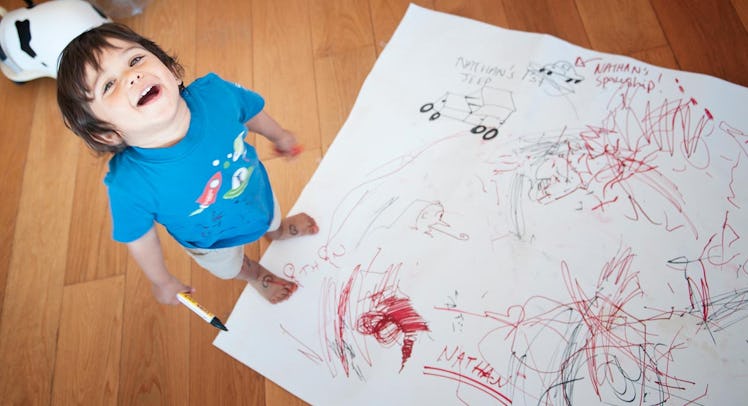6 Essential Steps To Getting Your Toddler To Play Independently
Just leave them the hell alone.

For some bizarre reason people equate being alone with being lonely. One is not, in fact, the loneliest number that you’ll ever do. Even Tom Hanks wasn’t particularly lonely when he was stranded on that island. Sure, he did turn a volleyball into a companion. But that just shows how being alone can foster insani … uh. Creativity!
RELATED: Why Danish Parents (And Their Kids) Are Happier Than Americans
And you know who has creativity in spades? Your toddler. Their brains are pretty much built for it. But you’ll never see that unless you can get them to play independently. Have no clue how to make that happen? It’s easy peasy. Abandon them on an island! (Joking!)
Why It’s Needed
A toddler who can play on their own (without screens, natch) stretches their creative muscles and basically becomes a better person. Play is work, exploration and education rolled into one engrossing activity (kind of like being Ron Jeremy).
The bonus of them playing independently is that it’s just that: They’re no dependent. It allows you to do the shit that you need to do. Which is probably why you’re actually reading this. And that’s totally okay. Here’s how to get it done.
Make A Play Space
Your kid will have more success playing on their own if they’re hanging out in a space they enjoy and aren’t going to get injured in. While your random room full of broken beer bottles would probably interest them, it doesn’t really fit the safety bill.
Happily, with some good childproofing in place, this can be literally any room in your house. You don’t need a ball pit and mural of Tatooine (mostly because there were no ball pits on Tatooine). You do need some soft edges and a couple toys though.
Have The Right Toys
About those toys. They don’t actually have to be toys. In fact, toddlers love things that aren’t toys. Case in point, how often you find your garlic press under their bed.
Opt for toys that are open ended. Which is to say, supply them with toys that allow them to build and tell their own stories. Pots, pans, utensils and blocks are perfect. Go to the Home Depot, grab some latches and knobs, and slap those on a board. Or fill a shallow pan with a little bit of water. This isn’t hard.
You can also follow their lead. Don’t limit it. If they want to watch the ants on your counter, let them do that (and call the exterminator later, because gross). The point is that you want them to lose themselves in whatever they’re doing.
Avoid the electric crapola that takes batteries and tells your kid how to play. This, of course, has the added benefit of making it quieter … for you. Shhhhhh.
Get Messy
Obviously, if you’re following your kid’s lead, things might get weird and sloppy. Take a breath and just let it happen. After all, are you more concerned about cleaning up kid mess, or getting some damn time pay some bills … by which you mean drink a couple beers in peace?
Practice While Being Close By
A kid who’s had a parent at their side constantly may have a tough time getting into the swing of independent play. It’ll probably take a little practice. So start out by setting them up with something they dig and then sit a little ways away doing your own thing.
Look over once in awhile and offer some encouragement, but set firm boundaries if they’re refusing to extricate themselves from you. Communicate and let them know what you’re doing. Set a timer if necessary.
Schedule It
Speaking of boundaries, make sure you make solitary play a part of their regular schedule. This will add a sense of comfort and stability. Once they know that playing alone is just part of the day, between paling around with you, it’ll get easier for them to detach.
Leave Them The Hell Alone
This is the biggest hurdle. You want to leave your kid to their play. Because the second you step in and tell them the engineering on their block tower is not to code, you will ruin everything.
The trick is to just observe. You don’t need to chime in. You don’t need to offer suggestions. But if their block tower inevitably does fall due to shoddy toddler engineering, you’re just going to make like Howard Cosell. Describe what you saw. Ask what they’re going to do next. They’ll get back into it.
If they come to you for help, try to keep as hands-off as you can. Questions are good here. Wonder out loud how they plan to approach the problem. Then, once the momentum kicks back in, back away.
With a bit of practice and patience, you’ll be able to step into the next room and listen to your kid building their own world. Though, once they start talking to Wilson, it might be time to pop back in before they decide to make fire.
This article was originally published on